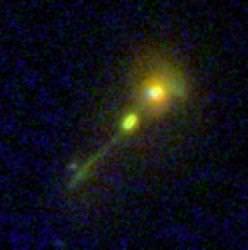Quasars are some of the brightest objects in the Universe. Just a single quasar can blaze more than a hundred times more brightly than our entire Milky Way galaxy. It turns out, though, that some of the brightest quasars in the Universe are hidden, cloaked behind a shroud of gas and dust. But now researchers have developed a technique to find the galaxies hiding these bright quasars. It turns out, they’re everywhere, we just couldn’t see them.
This blazing material surrounding a supermassive black hole is a quasar. The relatively tiny region around a black hole can blaze more than a hundred times as brightly as our own Milky Way galaxy. But there’s a paradox. The more powerful the quasar, the better a job it can do to hide itself within a shroud of gas and dust.
To see the hidden quasars, you can’t look in the visible spectrum. You need to use a wavelength that isn’t obscured by gas and dust, such as infrared and X-rays. However, previous surveys in these wavelengths have only revealed small portions of the sky.
Astronomers from Princeton and the Institute for Advanced Study announced today that they have developed a technique to see the telltale signs that a galaxy contains a bright quasar – without having to perform an extensive survey in these other wavelengths. By sifting through the Sloan Digital Sky Survey, looking for very special characteristics of the light coming from a galaxy, the team uncovered 887 hidden quasars; the largest number ever detected.
“We determined how common hidden quasars are, especially the most luminous ones. Perhaps more interestingly, we determined how common they are relative to normal quasars,” said team member Nadia Zakamska, a NASA Spitzer Fellow at the Institute for Advanced Study in Princeton.
“We found that hidden quasars make up at least half of the quasars in the relatively recent Universe, implying that most of the powerful black holes in our neighborhood had previously been unrecognized.”
This means that there are many hidden quasars out there. And it also means that quasars are much more efficient at converting matter into light than astronomers previously realized. In fact, most of the light released by quasars is probably absorbed by intervening gas and dust.
In other words, even though quasars are incredibly bright objects, blazing with hundreds of times the light of an entire galaxy, that’s probably just the tip of the iceberg.
They’re much much brighter.
Original Source: SDSS News Release

